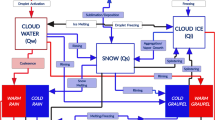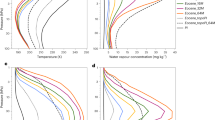Abstract
SINCE the discovery of the springtime Antarctic ozone depletion1–2 a great deal of attention has been given to processes related to aerosol formation and heterogeneous chemistry at low tem-peratures. Polar stratospheric cloud (PSCs),3 are frequent features of the southern winter atmosphere, and may provide a site for heterogeneous reactions that lead to ozone destruction4,5. Models have been proposed6–8 for the formation of PSCs based on the condensation of HNO3 (see ref. 9 for a review). An optical radar (lidar) has been operated at Amundsen Scott (South Pole), Antarctica, since the austral summer 1987–88. Observations made during the 1988 polar night show the presence of PSCs. Here we report ozonesonde measurements made quasi-simultaneously at the South Pole which indicate sharp minima of the ozone concentration in the vicinity of the PSCs. Although definitive information is unavailable for unambiguous interpretation of the results, the data may be viewed as evidence either for the role of dynamics in transporting air of different composition in conditions of substantial stability, or for processes leading to ozone destruction during the polar winter; the latter may include heterogeneous chemical reactions taking place in the absence of photolysis.
This is a preview of subscription content, access via your institution
Access options
Subscribe to this journal
Receive 51 print issues and online access
$199.00 per year
only $3.90 per issue
Buy this article
- Purchase on Springer Link
- Instant access to full article PDF
Prices may be subject to local taxes which are calculated during checkout
Similar content being viewed by others
References
Chubachi, S. Mem. Natl Inst. Polar Res. Jap., Spec. Iss. 34, 13–19 (1984).
Farman, J. C., Gardiner, B. G. & Shanklin, J. D. Nature 315, 207–210 (1985).
McCormick, M. P., Steele, H. M., Hamill, P., Chu, P. W. & Swissler, T. J. J. atmos. Sci. 39, 1387–1397 (1982).
Solomon, S., Garcia, R. R., Rowland, F. S. & Wuebbles, D. J. Nature 321, 755–758 (1986).
McElroy, M. B., Salawitch, R. J., Wofsy, S. C. & Logan J. A. Nature 321, 759–762 (1986).
Cruzen, P. & Arnold, F. Nature 324, 651–655 (1987).
Toon, O. B., Hamill, P., Turco, R. P. & Pinto, J. Geophys. Res. Lett. 13, 1284–1288 (1986).
Hamill, P., Toon, O. B. & Turco, R. P. Geophys Res. Lett. 13, 1288–1291 (1986).
Solomon, S. Rev. Géophys. 26, 131–148 (1988).
Komhyr, W. D. Ann. Géophys. 25, 203–210 (1969).
Komhyr, W. D., Lathrop, J. A., Poston, R. W. & Mullen, T. D. National Oceanic and Atmospheric Administration (Air Resources Laboratory), Data Report ERL ARL-18 (U.S. Department of Commerce, Silver Spring, 1989).
Author information
Authors and Affiliations
Rights and permissions
About this article
Cite this article
Fiocco, G., Komhyr, W. & Fuà, D. Is ozone destroyed during the Antarctic winter in the presence of polar stratospheric clouds?. Nature 341, 426–427 (1989). https://doi.org/10.1038/341426a0
Received:
Accepted:
Issue Date:
DOI: https://doi.org/10.1038/341426a0
This article is cited by
-
A dent outside the hole?
Nature (1989)
Comments
By submitting a comment you agree to abide by our Terms and Community Guidelines. If you find something abusive or that does not comply with our terms or guidelines please flag it as inappropriate.



